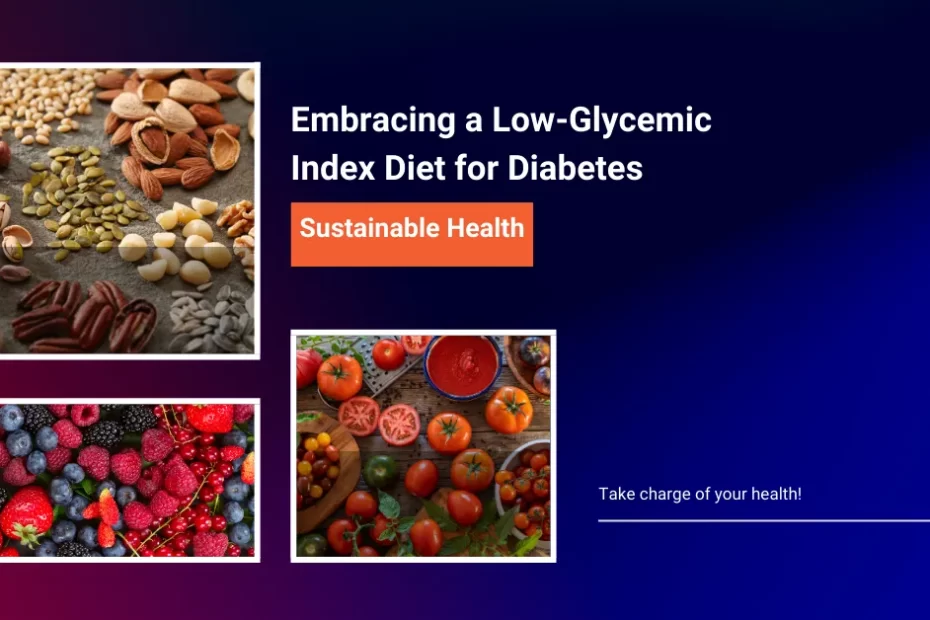Last updated on August 22nd, 2023 at 06:03 pm
Are you struggling to manage your diabetes through diet alone? Have you heard about the benefits of a low-glycemic index diet but aren’t sure where to start? If so, you’re in the right place. Embracing a low-glycemic index diet can be a game-changer for individuals with diabetes, helping to stabilize blood sugar levels and improve overall health.
Diabetes is a chronic disease that affects millions of Americans. If you or someone you love has diabetes, then you already know how important it is to eat well. A diabetic meal plan should be designed around what you are able to consume.
You may need to cut back on certain foods or increase others. It is important to follow a healthy eating pattern for good blood sugar control. Diabetics often struggle with their food choices because they don’t always know what foods are good for them.
A Diabetic meal plan should include protein, carbohydrates, fat, fiber, vitamins, minerals, and water. These nutrients are essential for keeping your body healthy and strong. They also help prevent complications from developing.
The Glycemic Index Made Easy: Streamline your diabetic meal planning
1. Protein is an essential macronutrient that helps build muscle mass and maintain bone density. A diet high in protein may help reduce body fat levels and improve insulin sensitivity.
Rich foods (protein) include meat, poultry, fish, eggs, dairy products, beans, nuts, seeds, soybeans, tofu, and whole grains.
2. Fat is an essential macro nutrient that provides calories and serves as a major storage depot for vitamins and minerals. Foods rich in fat provide essential fatty acids (EFAs) that cannot be synthesized by the human body.
EFAs play a role in maintaining normal brain function, hormone production, and cellular integrity. Sources of dietary fats include meats, oils, butter, cheese, milk, yogurt, and eggs.
3. Carbohydrates are the primary fuel source for the body. These complex molecules consist of carbon, hydrogen, oxygen, and nitrogen atoms. Sugars, starches, and fiber are examples of carbohydrate food groups.
Complex carbohydrates are digested slowly and release glucose into the bloodstream over time. Simple carbohydrates are broken down rapidly and give rise to a quick spike in blood sugar. Examples of simple carbohydrates include white bread, pasta, rice, crackers, cookies, cakes, candy, soda, fruit juice, and sugary drinks.
4. Fiber is a type of carbohydrate that does not break down easily in the digestive system. Instead, it passes through the gastrointestinal tract without being absorbed. Dietary fibers have been shown to lower cholesterol levels, prevent heart disease, and promote regular bowel movements. Common sources of dietary fiber include fruits, vegetables, legumes, nuts, seeds, and whole-grain cereals.
5. Water is necessary for many bodily processes including digestion, elimination, and regulation of internal temperature. Most people do not drink enough water each day. Adults should consume at least eight 8-ounce glasses of water per day. Children need even more water than adults due to their smaller size and higher metabolic rate.
9+ Low Glycemic Index Foods That Make Life Easier For People With Diabetes
- Non-starchy vegetables such as spinach, broccoli, and kale.
- Legumes such as lentils, chickpeas, and kidney beans.
- Nuts such as almonds, walnuts, and pecans.
- Seeds such as chia seeds, flaxseeds, and pumpkin seeds.
- Whole grains such as quinoa, brown rice, and bulgur.
- Berries such as blueberries, strawberries, and raspberries.
- Citrus fruits such as oranges, grapefruit, and lemons.
- Sweet potatoes and yams.
- Tomatoes.
- Avocado.
In addition to being low in glycemic index, these foods also offer a range of important nutrients, such as fiber, vitamins, and minerals, that are important for maintaining overall health.
Glycemic Index Calculator
Glycemic Index Calculator
Note:
The glycemic index is a measure of how quickly a food raises blood sugar levels.
However, since these foods (Fish & Seafood) contain very little carbohydrate, they do not have a glycemic index value. The glycemic index is only applicable to foods that contain carbohydrates.
Healthy Fish Calorie Calculator
The Healthy Fish Calorie Calculator is a great online tool to help you work out the nutritional value of different types of fish. It allows you to calculate the number of calories, fat, protein, and other nutrients in a serving size. It also includes information on which cooking methods are best for retaining nutrients. With this calculator, it’s easy to ensure that you are getting the most nutrition out of your meals when opting for fish!


Don’t forget about whole grains like quinoa and sweet potatoes! These complex carbohydrates provide sustained energy and have a lower impact on blood sugar levels compared to refined grains. Embrace the goodness of nature’s grains in your diabetic-friendly diet.
I read your article, and I think your way of writing has given me some innovative ideas, thank you very much.
There are many meal plans available for people with diabetes. A good diabetic meal plan should include complex carbohydrates, lean protein, and healthy fats
The low glycemic diet is indeed a dietary approach that focuses on consuming foods that have a lower impact on blood sugar levels. It can be particularly helpful for individuals looking to manage their blood sugar, improve insulin sensitivity, or support weight management.
Thanks for shedding light on the importance of understanding the GI Index, especially for those of us trying to manage diabetes or pre-diabetes.